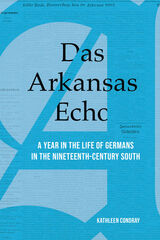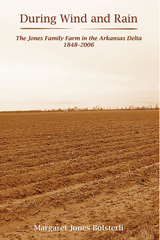238 books about Arkansas and 13
start with D
238 books about Arkansas and 13
238 books about Arkansas
13 start with D start with D
13 start with D start with D

Daddy’s Money
A Memoir of Farm and Family
Jo McDougall
University of Arkansas Press, 2011
Jo McDougall brings a poet's sensibility to memoir. Recounting five generations of Delta rice farmers, through family archives and oral histories, she traces how the clan made their way into the fabric of America, beginning with her Belgian-immigrant grandfather, a pioneer rice farmer on the Arkansas Delta at the turn of the twentieth century. As John Grisham has for a 1950s Arkansas cotton farm, McDougall illuminates an Arkansas rice farm in the 1930s and 1940s. The Garot family's acreage near DeWitt and the town itself provide the stage for McDougall's wry, compelling, and layered account of the day-to-day of rice growing on the farm that her father inherited. In that setting she discovers a rich "universe of words" in the Great Depression, comes of age during World War II, and finds her way alongside "that whole quirky, compelling cast of characters" that comprised her kin. In this conflicted, ironic, southern-but-universal account of betrayal, heartbreak, loss, and joy, "the vagaries and the grace" of the land join forces with the power of money as family bonds are both forged and dissolved. Deeply felt, unsentimental, and often humorous,Daddy's Money presents McDougall's life and the lives of her relatives in the way that all our lives are eventually framed-as stories. "When all else is lost," the author maintains, "the stories remain."
[more]

Dardanelle and the Bottoms
Environment, Agriculture, and Economy in an Arkansas River Community, 1819-1970
Mildred D. Gleason
University of Arkansas Press, 2017
Between 1819 and 1970, the town of Dardanelle, Arkansas, located on the south side of the Arkansas River in Yell County, Arkansas, experienced sustained prosperity and growth made possible by the nearby farming community known as the Dardanelle Bottoms.
A reciprocal relationship between the town and the Bottoms formed the economic backbone on which the area’s well-being was balanced. The country people came to town on Saturdays to buy their groceries and supplies, to shop and take in a movie or visit the pool halls or barbershops. Merchants relied heavily on this country trade and had a long history of extending credit, keeping prices reasonable, and offering respect and appreciation to their customers.
This interdependence, stable for decades, began to unravel in the late 1940s with changes in farming, particularly the cotton industry. In Dardanelle and the Bottoms, Mildred Diane Gleason explores this complex rural/town dichotomy, revealing and analyzing key components of each area, including aspects of race, education, the cotton economy and its demise, the devastation of floods and droughts, leisure, crime, and the impact of the Great Depression.
A reciprocal relationship between the town and the Bottoms formed the economic backbone on which the area’s well-being was balanced. The country people came to town on Saturdays to buy their groceries and supplies, to shop and take in a movie or visit the pool halls or barbershops. Merchants relied heavily on this country trade and had a long history of extending credit, keeping prices reasonable, and offering respect and appreciation to their customers.
This interdependence, stable for decades, began to unravel in the late 1940s with changes in farming, particularly the cotton industry. In Dardanelle and the Bottoms, Mildred Diane Gleason explores this complex rural/town dichotomy, revealing and analyzing key components of each area, including aspects of race, education, the cotton economy and its demise, the devastation of floods and droughts, leisure, crime, and the impact of the Great Depression.
[more]

Das Arkansas Echo
A Year in the Life of Germans in the Nineteenth-Century South
Kathleen Condray
University of Arkansas Press, 2020
In the late nineteenth century, a thriving immigrant population supported three German-language weekly newspapers in Arkansas. Most traces of the community those newspapers served disappeared with assimilation in the ensuing decades—but luckily, the complete run of one of the weeklies, Das Arkansas Echo, still exists, offering a lively picture of what life was like for this German immigrant community.
“Das Arkansas Echo”: A Year in the Life of Germans in the Nineteenth-Century South examines topics the newspaper covered during its inaugural year. Kathleen Condray illuminates the newspaper’s crusade against Prohibition, its advocacy for the protection of German schools and the German language, and its promotion of immigration. We also learn about aspects of daily living, including food preparation and preservation, religion, recreation, the role of women in the family and society, health and wellness, and practical housekeeping. And we see how the paper assisted German speakers in navigating civic life outside their immigrant community, including the racial tensions of the post-Reconstruction South.
“Das Arkansas Echo”: A Year in the Life of Germans in the Nineteenth-Century South offers a fresh perspective on the German speakers who settled in a modernizing Arkansas. Mining a valuable newspaper archive, Condray sheds light on how these immigrants navigated their new identity as southern Americans.
“Das Arkansas Echo”: A Year in the Life of Germans in the Nineteenth-Century South examines topics the newspaper covered during its inaugural year. Kathleen Condray illuminates the newspaper’s crusade against Prohibition, its advocacy for the protection of German schools and the German language, and its promotion of immigration. We also learn about aspects of daily living, including food preparation and preservation, religion, recreation, the role of women in the family and society, health and wellness, and practical housekeeping. And we see how the paper assisted German speakers in navigating civic life outside their immigrant community, including the racial tensions of the post-Reconstruction South.
“Das Arkansas Echo”: A Year in the Life of Germans in the Nineteenth-Century South offers a fresh perspective on the German speakers who settled in a modernizing Arkansas. Mining a valuable newspaper archive, Condray sheds light on how these immigrants navigated their new identity as southern Americans.
[more]

Dearest Letty
The World War II Love Letters of Sgt. Leland Duvall
Leland Duvall
University of Arkansas Press, 2011
Leland Duvall was a now-and-again farm worker with a grade-school education when he received his World War II draft notice at his father's farm near Moreland, Arkansas, in March of 1942. He departed for training in California, where he began to write to Letty Jones, a Pottsville girl he'd had a crush on for several years. From the first correspondence through the end of the war, Leland sent Letty a torrent of letters, hundreds of careful and undeniably heartfelt missives-utterly tender but never sentimental, reliably charming and gently humorous-written daily from desert sands, pup tents, hospital beds, armored cars, and bombed-out buildings. That Duvall's writing is a tour de force of wit, elegance, and erudition is all the more poignant because he was a man who was almost entirely self-taught. The letters, discovered by Duvall's daughter four years after his death in 2010, are here enriched by his longtime friend and colleague Ernie Dumas, who provides facts about where Duvall was and the perils he endured while penning his epistles, information that was often missing in dispatches that were necessarily censored and always guided by Duvall's effort not to bore or worry his "dearest Letty." Duvall's lively intelligence and obvious joy in writing come through on every page, joining with vividness the patina of the time and the bright shine of a timeless love affair.
[more]

Defining Moments
Historic Decisions by Arkansas Governors from McMath through Huckabee
Robert L. Brown
University of Arkansas Press, 2010
Defining Moments explores how all Arkansas governors since Sid McMath (a group that has produced a president, two U.S. senators, and two presidential contenders) acted in times of crisis. These ten exceptional leaders stand out in Arkansas history and politics for having had their personal and political mettle tested by issues concerning education, the environment, social justice, the conduct of politics, race, and more of the nation's defining debates. The governors and situations covered include Sid McMath's bout with the Dixiecrats; Francis Cherry's ploy to label his opponent a Communist; Orval Faubus's decision to block integration at Little Rock Central High; Winthrop Rockefeller's tribute to Martin Luther King Jr. on the State Capitol steps; Dale Bumpers's battle against political corruption; David Pryor's veto of the U.S. Corps of Engineers's Bell Folley Dam; Frank White's endorsement of Creationism; Bill Clinton's decision to test public school teachers; Jim Guy Tucker's bold solution for the Medicaid program and his resignation; and Mike Huckabee's quest to consolidate the state's high school districts. Robert Brown, who knew nine of the ten governors personally and worked as an aide for Dale Bumpers and Jim Guy Tucker, tells these stories with an unusual combination of historical research and personal familiarity. He crystallizes the difficult choices faced by these memorable leaders, showing how their decisions at crucial points shaped their tenures, molded their legacies for good or bad, and shaped history.
[more]

The Die Is Cast
Arkansas Goes to War, 1861
Mark K. Christ
Butler Center for Arkansas Studies, 2010
Five writers examine the political and social forces in Arkansas that led to secession and transformed farmers, clerks, and shopkeepers into soldiers. Retired longtime Arkansas State University professor Michael Dougan delves into the 1861 Arkansas Secession Convention and the delegates’ internal divisions on whether to leave the Union. Lisa Tendrich Frank, who teaches at Florida Atlantic University, discusses the role Southern women played in moving the state toward secession. Carl Moneyhon of the University of Arkansas at Little Rock looks at the factors that led peaceful civilians to join the army. Thomas A. DeBlack of Arkansas Tech University tells of the thousands of Arkansans who chose not to follow the Confederate banner in 1861, and William Garret Piston of Missouri State University chronicles the first combat experience of the green Arkansas troops at Wilson’s Creek.
[more]

Digging for History at Old Washington
Mary L. Kwas
University of Arkansas Press, 2009
Positioned along the legendary Southwest Trail, the town of Washington in Hempstead County in southwest Arkansas was a thriving center of commerce, business, and county government in the nineteenth century. Historical figures such as Davy Crockett and Sam Houston passed through, and during the Civil War, when the Federal troops occupied Little Rock, the Hempstead County Courthouse in Washington served as the seat of state government. A prosperous town fully involved in the events and society of the territorial, antebellum, Civil War, and Reconstruction eras, Washington became in a way frozen in time by a series of events including two fires, a tornado, and being bypassed by the railroad in 1874. Now an Arkansas State Park and National Historic Landmark, Washington has been studied by the Arkansas Archeological Survey over the past twenty-five years. Digging for History at Old Washington joins the historical record with archaeological findings such as uncovered construction details, evidence of lost buildings, and remnants of everyday objects. Of particular interest are the homes of Abraham Block, a Jewish merchant originally from New Orleans, and Simon Sanders from North Carolina, who became the town’s county clerk. The public and private lives of the Block and Sanders families provide a fascinating look at an antebellum town at the height of its prosperity.
[more]

Distinguishing the Righteous from the Roguish
The Arkansas Supreme Court, 1836–1874
J.W. Looney
University of Arkansas Press, 2016
During the period from 1836 to 1874, the legal system in the new state of Arkansas developed amid huge social change. While the legislature could, and did, determine what issues were considered of importance to the populace, the Arkansas Supreme Court determined the efficacy of legislation in cases involving land titles, banks, transportation, slavery, family law, property, debt, contract, criminal law, and procedure.
Distinguishing the Righteous from the Roguish examines the court’s decisions in this era and shows how Arkansas, as a rural slave-holding state, did not follow the transformational patterns typical of some other states during the nineteenth century. Rather than using the law to promote broad economic growth and encourage social change, the Arkansas court attempted to accommodate the interests of the elite class by preserving the institution of slavery. The ideology of paternalism is reflected in the decisions of the court, and Looney shows how social and political stability—an emphasis on preserving the status quo of the so-called “righteous”—came at the expense of broader economic development.[more]

A Documentary History of Arkansas
C. Fred Williams
University of Arkansas Press, 2013
A Documentary History of Arkansas provides a comprehensive look at Arkansas history from the state's earliest events to the present. Here are newspaper articles, government bulletins, legislative acts, broadsides, letters, and speeches that, taken collectively, give a firsthand glimpse at how the twenty-fifth state's history was made. Enhanced by additional documents and brought up to date since its original publication in 1984, this new edition is the standard source for essential primary documents illustrating the state's political, social, economic, educational, and environmental history.
[more]

A Documentary History of Arkansas
C. Fred Williams
University of Arkansas Press
This collection of documents represents a behind-the-scenes look at Arkansas from earliest times to 1984. Here are newspaper articles, government bulletins, legislative acts, broadsides, letters, and speeches. Collectively, they give a firsthand glimpse at how the twenty-fifth state’s history was made. Consideration is given to social and cultural aspects of Arkansas history, with special attention focused on the role played by women and blacks.
[more]

Doing Development in Arkansas
Using Credit to Create Opportunity for Entrepreneurs Outside the Mainstream
Richard Taub
University of Arkansas Press, 2004
This is the story of the Southern Development Bancorporation, an organization established in 1988 with headquarters in Arkadelphia, Arkansas, for the purpose of stimulating economic and community development in South Arkansas. Richard P. Taub chronicles this experiment in development banking, established by Bill Clinton when he was governor. Based somewhat on the model of Shorebank Corporation, a Chicago bank-holding corporation that had achieved national recognition through its development efforts in the South Shore community, Southern was established with the assistance of the state’s leading foundation as a holding company with a set of subsidiaries designed to provide crucial credit opportunities and technical assistance missing from southern Arkansas.
Doing Development in Arkansas is a history of that program as its creators tried to find their footing in new terrain, establish trust, work with borrowers despite legal pitfalls in doing so, and attempted to create new loan and technical assistance products. It is the story of the towns themselves in which Southern tried to have a substantial impact, including Arkadelphia, Hope, Malvern, Hot Springs, and Pine Bluff. Southern was an experiment and many of its achievements were the results in some cases of trying new ideas and in others of transporting programs successful in one setting to new locations. The most dramatic example of such a move is the development of the Good Faith Fund in Pine Bluff, based on a model of the Grameen Bank in Bangladesh.
Doing Development in Arkansas is a history of that program as its creators tried to find their footing in new terrain, establish trust, work with borrowers despite legal pitfalls in doing so, and attempted to create new loan and technical assistance products. It is the story of the towns themselves in which Southern tried to have a substantial impact, including Arkadelphia, Hope, Malvern, Hot Springs, and Pine Bluff. Southern was an experiment and many of its achievements were the results in some cases of trying new ideas and in others of transporting programs successful in one setting to new locations. The most dramatic example of such a move is the development of the Good Faith Fund in Pine Bluff, based on a model of the Grameen Bank in Bangladesh.
[more]

Down and Dirty Down South
Politics and the Art of Revenge
Roger Glasgow
Butler Center for Arkansas Studies, 2016
Returning from a vacation trip to Mexico, Little Rock attorney Roger Glasgow and his wife got the surprise of their lives when they were stopped at the border crossing. Guards ordered them out of their car and began to remove the back seat. What followed was a long nightmare of political intrigue and subterfuge that led all the way back to Arkansas and its capital city.
While pursuing a race for district prosecutor in the 1970s, Glasgow had run afoul of the local political machine. The machine later decided to teach Glasgow a lesson even though he’d lost the race. Down and Dirty Down South is Glasgow’s story of how he attempted to clear his name and also track down the people who had set him up for charges of smuggling illegal drugs into the United States.
While pursuing a race for district prosecutor in the 1970s, Glasgow had run afoul of the local political machine. The machine later decided to teach Glasgow a lesson even though he’d lost the race. Down and Dirty Down South is Glasgow’s story of how he attempted to clear his name and also track down the people who had set him up for charges of smuggling illegal drugs into the United States.
[more]

During Wind and Rain
The Jones Family Farm in the Arkansas Delta 1848-2006
Margaret Jones Bolsterli
University of Arkansas Press, 2008
n telling the story of five generations of her family and its farm in the Arkansas Delta, Margaret Jones Bolsterli brings together her own research, historical perspective, and family lore as it reaches her from the days of her great-grandfather down to her nephew. The result is a family saga that is at once universal and personal, historical and timeless. During Wind and Rain moves from the land’s acquisition in 1848 through the Civil War and Reconstruction, the 1927 Flood, the Great Depression, and the drought of 1930 to the modern considerations of mechanization, fertilizer, pesticides, and irrigation. The transformation of dense swamp and forest to today’s commercial agriculture is the story of two hundred acres worked by people sowing their fate with sweat, ingenuity, and luck. From the hoes of Bolsterli’s great-grandfather Uriah’s time to her nephew Casey’s machinery capable of cultivating an acre in five minutes, During Wind and Rain poignantly portrays five generations of farmers motivated by dreams of “a crop so good that the memory of it can warm the drafty floors of adversity for the rest of one's life.”
[more]
READERS
Browse our collection.
PUBLISHERS
See BiblioVault's publisher services.
STUDENT SERVICES
Files for college accessibility offices.
UChicago Accessibility Resources
home | accessibility | search | about | contact us
BiblioVault ® 2001 - 2024
The University of Chicago Press









